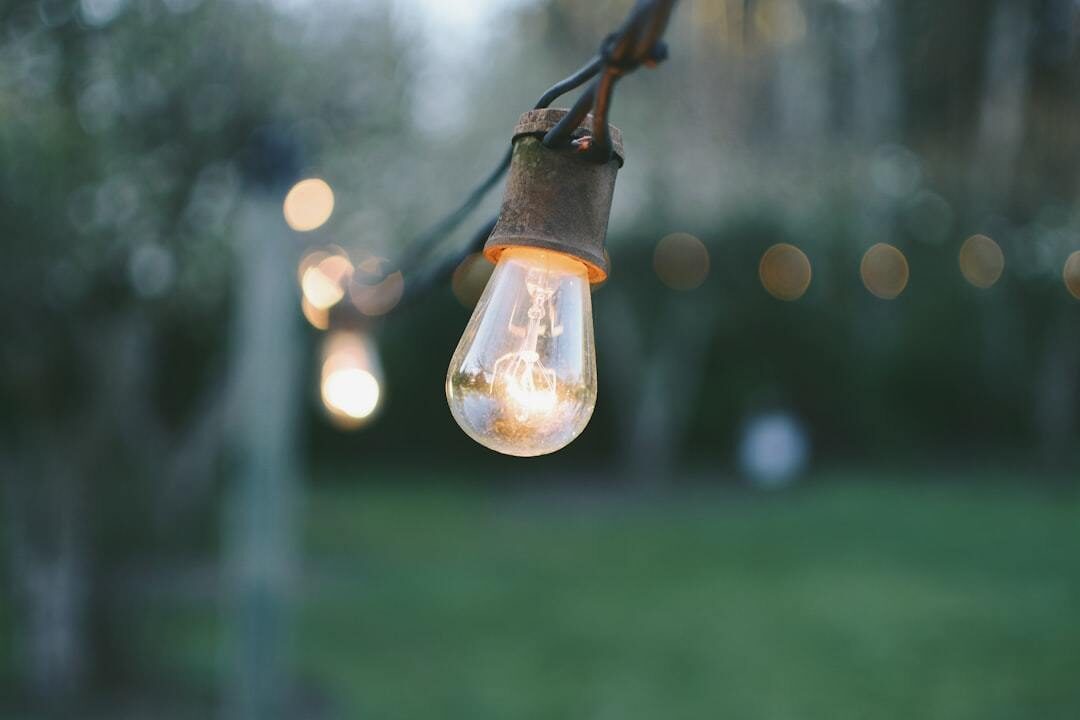Picture this: you’ve set up the perfect outdoor space, but as dusk falls, it becomes a haven for buzzing guests of the six-legged variety. It’s not just annoying; it can ruin your peaceful evening under the stars. But here’s some good news – choosing what outdoor lights don’t attract bugs could be your ticket to a bug-free zone. This post dives deep into why certain bulbs become bug magnets and others don’t.
We’ll explore everything from LED bulbs that keep critters at bay to color temperatures that won’t invite an insect party. Plus, we’ll share practical installation tips to further shield your oasis from unwelcome visitors. So if you’re ready to reclaim your night-time serenity without resorting to harsh chemicals or zappers, stick around. Our electricians are always ready to help with your outdoor landscape lighting in Bucks County area.
The Science Behind Bug Attraction to Outdoor Lights
Ever wonder why bugs seem magnetically drawn to your outdoor lights? It boils down to positive phototaxis and the light spectrum, two scientific principles that sound complex but are surprisingly straightforward.
Understanding Positive Phototaxis
Bugs exhibit what scientists call positive phototaxis. This fancy term simply means they’re naturally attracted to light. The reasons behind this attraction range from navigation purposes to finding food sources or mates. Imagine trying to find your way without GPS; for insects, bright lights serve as a makeshift guide in the darkness of night.
In an eye-opening experiment conducted by researchers, almost 9000 bugs were caught around different light sources, showcasing just how powerful this attraction can be. For more detailed insights into their findings on bug behavior patterns and attractions towards various lighting types, you might want to check out research conducted at University of North Carolina.
The Role of Light Spectrum in Bug Attraction
Different parts of the light spectrum have varying degrees of attractiveness to our six-legged friends. Blue or ultraviolet light is like a beacon for many flying insects which explains why traditional incandescent bulbs tend to lure more bugs than others—they emit more UV rays.
However, here’s some good news: not all lights spell dinner time for pests. LED bulbs with warmer color temperatures prove far less enticing because they emit less blue and ultraviolet wavelengths—making them your best bet if you’re looking to minimize uninvited guests during your next backyard barbecue.
Comparing Outdoor Light Types and Their Bug Attraction Levels
Ever noticed how some porch lights turn your evening hangout into a bug magnet, while others don’t? It’s all about the light type. Here’s what you need to know.
Understanding Positive Phototaxis
Bugs are drawn to outdoor lights due to positive phototaxis, meaning they’re naturally attracted to bright sources. This can make your outdoor area less enjoyable during warmer months.
Different bulbs emit varying spectrums of light which either invite or repel these flying party crashers. Studies have shown that nearly 9000 bugs can be caught in a single night using certain types of lighting.
The Role of Light Spectrum in Bug Attraction
Lights mimic natural signals for bugs, leading them right to your door. Incandescent bulbs top the list for attracting the most nocturnal visitors, closely followed by compact fluorescent (CFL) and halogen bulbs.
In contrast, LED lights with cool color temperatures tend to attract fewer insects than their incandescent counterparts but still more than warm LEDs do. According to research from the University of North Carolina, this is because cooler colors resemble daylight better than warm hues do.
If keeping bugs at bay is crucial for you, opting for warm LED bulbs might just be your best bet against unwanted guests—combining energy efficiency with reduced bug attraction levels makes them an excellent choice for any outdoor space looking for peace from pests without sacrificing brightness or style.
Why Warm LED Bulbs Are Your Best Bet Against Bugs
Energy Efficiency and Longevity
The battle against bugs doesn’t end with just choosing the right type of light; it’s also about opting for an energy-efficient solution. Warm LED bulbs stand out not only because they’re less appealing to our six-legged foes but also due to their incredible efficiency and long lifespan. Unlike traditional lighting options, LEDs consume significantly less power, translating into lower electricity bills and a smaller carbon footprint.
This isn’t just good news for your wallet; it’s great news for the planet too. The longevity of these bulbs means fewer replacements are needed over time, reducing waste. In fact, experiments have shown that warm LED bulbs attracted the fewest bugs compared to other types of lights, making them a double win for those looking to keep their outdoor spaces bug-free while being eco-conscious.
To understand more about why certain lights attract bugs more than others, checking out resources like the University of North Carolina’s study on bug attraction can give you deeper insights into how different light sources impact insect behavior in outdoor settings.
Innovative Solutions for Bug-Free Outdoor Lighting
Imagine enjoying a summer evening outdoors without the buzz of insects around your lights. This dream can become a reality with some innovative outdoor lighting solutions.
Citronella Candles and Their Dual Functionality
Citronella candles aren’t just for setting a mood; they’re workhorses in the fight against flying pests. By combining ambient light with bug repellent properties, these candles offer an effective way to enjoy your garden or patio after dusk. While studies at the University of North Carolina have shown that certain lights attract fewer bugs, adding citronella into the mix enhances this effect by actively repelling them.
The dual functionality of citronella candles makes them a smart addition to any outdoor space. Not only do they provide gentle illumination that doesn’t fall within most bugs’ flight path but also create a protective barrier against those night-flying nuisances.
To further reduce bug attraction, consider using multiple sources of light spaced out rather than one bright source which tends to draw more attention from nocturnal insects looking for food sources or mates—think strategically placed low-impact LED bulbs over high-beam floodlights.
Beyond traditional options like LEDs and halogen bulbs known for their efficiency, exploring less conventional choices such as yellow ‘bug’ lights designed specifically not to attract insects could be worth your while too—they emit wavelengths outside typical insect visual ranges making them invisible (and unattractive) stops on their nightly rounds.
Installation Tips for Minimizing Bug Attraction
Everyone loves a well-lit outdoor space, but not the bugs it attracts. Here’s how to reduce bug attraction with smart lighting installation.
Understanding Positive Phototaxis
Bugs are drawn to lights due to positive phototaxis. This means they naturally move towards light sources, mistaking them for natural ones like the moon and stars that guide their navigation. By installing lights closer to the ground and using multiple sources spaced out, you can minimize disruptions in their flight path and keep them away from your gatherings.
An interesting study showed almost 9000 bugs were attracted to various light sources over one summer-long experiment. It proved that some lights attract more bugs than others because of their placement and intensity.
The Role of Light Spectrum in Bug Attraction
Different parts of the light spectrum have varying effects on insects. Lights emitting blue or ultraviolet wavelengths tend to attract more nocturnal insects. Opting for warm LED bulbs or yellow ‘bug’ lights can significantly cut down on these unwanted guests since they emit less blue light.
In fact, research supports that warm LED bulbs are least attractive to flying pests among common bulb options available today. University of North Carolina researchers found this through extensive testing across different types of bulbs designed specifically for outdoor use.
Porch Lights That Don’t Attract Bugs – Tricks and Tips
Ever wonder why your evening outdoors turns into a bug fest? It’s all about the lights. But good news, you can enjoy your porch without uninvited guests buzzing around.
Choosing the Right Color Temperature
The key to keeping bugs at bay is picking porch lights with a less appealing color temperature for insects. Turns out, bugs aren’t fans of warm LED bulbs. In fact, these attracted the least amount of nocturnal insects in various experiments. Warm LEDs emit light that’s outside most flying critters’ preferred spectrum, making them less likely to crash your outdoor party.
This isn’t just about avoiding pests; it’s also energy-smart. Warm LED bulbs shine bright in terms of efficiency and longevity compared to their incandescent or fluorescent counterparts which not only attract more bugs but also hike up electricity bills.
To dive deeper into how specific lighting options fare against pesky intruders, check out insights from University of North Carolina. They’ve shed some light on how different sources stack up—incandescent bulbs being the biggest bug magnets followed by CFLs and halogens, while LEDs with cooler tones fall somewhere in between.
Incorporating citronella candles as part of your outdoor decor could add an extra layer of defense against mosquitoes while providing ambient lighting for those late-night chill sessions on the deck—a win-win.
Last tip: think strategically about installation locations. Spreading multiple sources around rather than clustering them helps minimize attractions along common flight paths near food sources—keeping those unwanted dinner guests away from where you relax.
Understanding Why Bugs Are Drawn To Light
The dance of bugs around outdoor lights is a familiar summer scene. But why are bugs attracted to light? It turns out, the answer lies in their biological wiring.
Understanding Positive Phototaxis
Insects exhibit what scientists call positive phototaxis, an innate attraction to light sources. This behavior has roots in survival instincts; natural light helps them navigate and find food sources. Artificial lighting throws a wrench into this system, confusing nocturnal insects and leading them straight to your porch light instead of moonlit paths they’re meant to follow.
A fascinating study from the University of North Carolina highlighted how different lights affect bug behavior. Nearly 9000 bugs were caught during their experiment, revealing a wealth of data on insect-light interactions.
The Role of Light Spectrum in Bug Attraction
Different parts of the light spectrum have varying effects on bug attraction levels. For instance, blue and ultraviolet (UV) lights are like beacons for many flying insects. On the flip side, yellow or warm-colored lights tend to repel rather than attract these night-fliers because they mimic wavelengths emitted by fire—something most insects instinctively avoid due to its association with danger.
This understanding is crucial when selecting outdoor lighting options. By choosing bulbs that emit less UV and more towards the yellow end of the spectrum—like LED bulbs designed specifically as ‘bug’ lights—you can significantly reduce your outdoor space’s attractiveness to pesky visitors without compromising visibility or ambiance.
Reducing Overall Outdoor Lighting To Deter Bugs
Who knew that the secret to a bug-free backyard might be as simple as turning down the lights? Yes, reducing outdoor lighting is not just good for your energy bill; it’s also a strategic move against those pesky flying critters.
Bugs are like party crashers drawn in by bright outdoor spaces. But here’s the kicker: they’re not fans of subtlety. This means dimming those glowing invitations can make your home less appealing on their radar. It’s all about finding that sweet spot between having enough light to navigate safely and keeping your space just dim enough to fly under their radar—literally.
The Role Of Blue Light In Attracting Insects
Ever wonder why bugs seem particularly fond of certain lights? It turns out, blue light is like bug catnip. These wavelengths mimic moonlight and starlight, guiding insects during nighttime navigation. However, when we flood our porches with blue-emitting bulbs, we create confusion in their flight path leading them straight to us.
To combat this, opt for bulbs designed with minimal blue light emissions or ones specifically labeled as ‘bug’ lights which emit yellow tones instead—a color far less enticing to night-flying insects. Not only does this reduce attraction but switching can save energy too. For more insight into how different types of light affect insect behavior check out University of North Carolina’s research.
Making these small adjustments doesn’t mean you have to compromise on safety or aesthetics either; it simply requires a bit more thoughtfulness in choosing where and how much artificial light you use after sunset.
The Role Of Blue Light In Attracting Insects
Have you ever noticed how certain lights turn your backyard into a bug magnet? It’s not just any light that does this trick; it’s primarily those emitting blue light. Let’s unpack why these glowing beacons are irresistible to insects and explore smarter lighting choices for your outdoor oasis.
Understanding Positive Phototaxis
Bugs aren’t crashing your evening parties out of spite. They’re drawn to blue light due to positive phototaxis, an innate attraction to light sources. This instinctual move is thought to help them navigate using natural moonlight and stars, which unfortunately means artificial lights can lead them astray.
To keep the peace in our backyards, steering clear of bulbs that emit strong blue wavelengths is key. But what alternatives do we have?
The Role of Light Spectrum in Bug Attraction
Different parts of the light spectrum have varying effects on insect behavior. While blue light acts like a beacon, other colors can actually repel or fail to attract bugs altogether.
In experiments with nearly 9000 bugs caught around different types of lights, researchers found that incandescent bulbs were particularly appealing because they emit more warmth and brightness—qualities similar to natural sunlight.
University of North Carolina studies suggest opting for warm LED bulbs as they attracted the least amount of nocturnal visitors.
This knowledge equips us with power—the power to choose outdoor lighting wisely and reduce unwanted guests at our next barbecue or late-night gathering under the stars.
Conclusion
Wrapping up, we’ve learned that not all lights are created equal when it comes to bug attraction. Key takeaway: LED bulbs, especially those with a warm color temperature, stand out as the best choice for what outdoor lights don’t attract bugs.
Remember this: Yellow tones over blue hues make a significant difference in keeping your evenings peaceful. And let’s not forget, spacing and placement can drastically reduce unwanted visitors without dimming your night-time ambiance.
Think practicality; energy-efficient LEDs not only save on bills but also minimize the buzz around your porch light. By now, you should feel equipped to create that bug-free outdoor space you’ve dreamed of.
To sum up: Choose wisely, position smarter. Enjoy those serene summer nights ahead.








